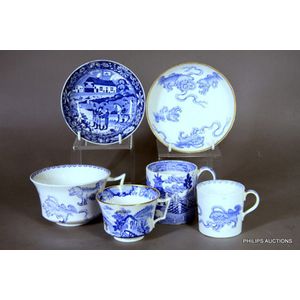Coalport Flora Trio with Gilt Scrolls, 1810-15
You must be a subscriber, and be logged in to view price and dealer details.
Subscribe Now to view actual auction price for this item
When you subscribe, you have the option of setting the currency in which to display prices to $Au, $US, $NZ or Stg.
- Circa - A Latin term meaning 'about', often used in the antique trade to give an approximate date for the piece, usually considered to be five years on either side of the circa year. Thus, circa 1900 means the piece was made about 1900, probably between 1895 and 1905. The expression is sometimes abbreviated to c.1900.
- Gilding - Gilding is a method of ornamentation whereby a thin sheet of gold metal is applied to items made of wood, leather, ceramics, glass and silver for decorative purposes.
For furniture including mirrors, the sheet of gold is usually applied over a coating of gesso. Gesso is a mixture of plaster of Paris and gypsum mixed with water and then applied to the carved wooden frames of mirrors and picture frames as a base for applying the gold leaf. After numerous coats of gesso have been applied, allowed to dry and then sanded a coat of "bole", a usually red coloured mixture of clay and glue is brushed on and allowed to dry, after which the gold leaf is applied. Over time parts of the gilding will rub off so the base colour can be seen. In water gilding, this was generally a blue colour, while in oil gilding, the under layer was often yellow. In Victorian times, gilders frequently used red as a pigment beneath the gold leaf.
Metal was often gilded by a process known as fire gilding. Gold mixed with mercury was applied and heated, causing the mercury to evaporate, the long-term effect of which was to kill or disable the craftsman or woman from mercury poisoning. The pursuit of beauty has claimed many victims, not the least of which were the artists who made those pieces so highly sought after today.
This item has been included into following indexes:
Visually similar items

A trio in the manner of Minton, circa 1810, comprising a can and a bute cup both with ring handles, bolding decorated with large white flower with star centres upon a wide mazarine blue border lavishly embellished with gilt flora and trailing leaves, unmar

Six blue and white tea wares Wedgwood and other, circa 1815, a Wedgwood coffee can, saucer and large teacup in the Chinese dragon and dog of fo pattern; a Chinoiserie cup with a French handle and old lead rivet repairs; a Chinoiserie mug; a Battle of Water

A Nantgarw tea cup and saucer, 1817-20, pattern 484, Empire shaped with a waisted foot and a high set loop handle decorated with a wide border of roses in urns, festoons, arching branches, pendants and torch motifs, in enamel colours and gilt upon a white

A Spode coffee can and saucer, circa 1800-1805, unmarked, the can with a single kick to the looped handle, finely decorated to both pieces in iron red, olive, gilt and matte bronze colours with neoclassical floral swags, fanned vegetal motifs, and gilded r
